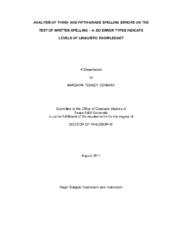| dc.description.abstract | A standardized test of spelling ability, Test of Written Spelling – 4, was used to explore the error patterns of Grade 3 and Grade 5 students in public and private schools in the southwestern region of the US. The study was for the purpose of examining the relationship between types of errors students make within a grade level (Grades 3 & 5 for this study), and the students’ spelling proficiency. A qualitative analysis of errors on the Test of Written Spelling – 4 (TWS-4) resulted in distributions of errors categorized as phonological, phonetic, orthographic, etymological, and morphological. For both Grades 3 and 5, a higher proportion of phonological and phonetic errors were made by students in the lowest spelling achievement group. Students with higher standard spelling scores made a lower proportion of phonological and phonetic errors and a higher proportion of errors categorized as etymological and morphological. The Test of Silent Word Reading Fluency (TOSWRF; Mather, Allen, Hammill, & Roberts, 2004) was also administered to the students to examine the relationship of these error types to literacy. The correlation between reading fluency standard scores and phonological and phonetic errors was negative, whereas the correlation between reading fluency and orthographic, etymological, and morphological error types was positive. This study underscores the value of looking at spelling achievement as a part of students’ literacy profiles. In addition, the study highlights the importance of making sure students beyond the years of very early reading and spelling development (Grades 3-5), especially those with low spelling proficiency, have the basic skills of phonological awareness and basic sound/symbol correspondences in place to support their ability to spell and to read, and that spelling must be taught in such a way as to meet students’ individual student needs. | en |


